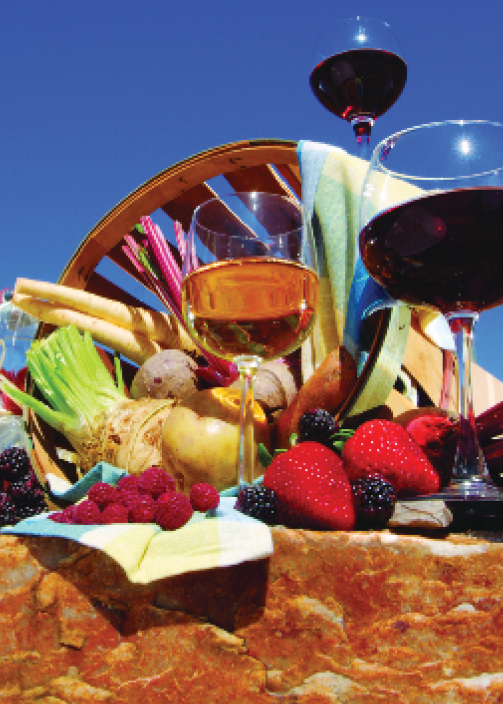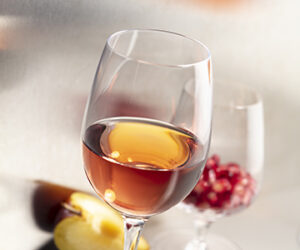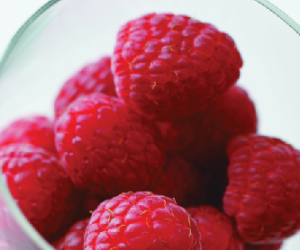
Grape, the Wine Vine
If you have productive wild grapes on your property, that may be enough for you. Or, you may want to plant a few vines on a fence, in a vineyard row, or wherever you can fit them in. First and foremost, one should consult with the local agricultural extension agent. You may want to take the second step and ask around as to who might be growing grapes locally, then go talk to the growers. Construct two lists. If folks say a certain grape grows well locally, put it on the list of grapes to consider planting. If they say a certain grape won’t grow well (or at all) locally, put it on the list of grapes to avoid. Don’t fight local wisdom. (The WineMaker department titled Backyard Vines discusses home viticulture in every issue of this magazine.)
Elderberry, the Wine Shrub
Elderberries grow wild throughout much of America, Canada, Mexico, the British Isles, Europe and Asia and have long been a favorite for wine. Sambucus simpsonii is the dominant elder from Louisiana through Florida. North and west of that, Sambucus canadensis (American Elder) dominates. Related cousins are the Sambucus cerulea (Blue Elder), Sambucus mexicana (Mexican Elder), Sambucus melanocarpa (Black Berried Elder) — all of which are edible. In Europe and Asia the popular edible elder is Sambucus nigra (Black Elder).
There are several minor elders that are toxic. These are not common, but do exist. A good edible plants guide will help you steer clear of them.
A couple of proven, edible elders planted in a corner of the yard will provide the winemaker with 3–9 lbs. (1.4–4.1 kg) of fruit each. And, you will need about 3 pounds of elderberries per gallon (0.35 kg/L) of elderberry wine.
Elderberries like damp soil — preferably slightly acidic — and will grow well in areas where drainage is a problem. But beware. Elders spread, with new plants rising from the roots. They can get out of hand after a
few years.
Blueberry, the Wine Bush
Blueberries belong to the genus Vaccinium. There are dozens of species and varieties of blueberries in the United States and Canada ranging from the Atlantic to the Pacific and the Gulf Coast to the Hudson Bay.
Vaccinium angustifolium (Lowbush Blueberry) is the species from which most commercial blueberries are harvested. Less common generally, but native to the northeast are the black Vaccinium brittonii and the blue Vaccinium vacillans. But most blueberries found in home gardens from Arkansas to Canada are varieties of Vaccinium corymbosum (Highbush Blueberry) or the more southern Vaccinium asheri (Rabbiteye Blueberry). Over 60 varieties have been introduced for the garden in the past 95 years, but the more recent varieties are clearly superior.
Probably the best tasting of the Highbush type are the Bounty, Darrow, Polaris, Sierra and Spartan. Of the Rabbiteye type, the best are probably the Bluebelle, Bonita, Garden Blue, Tifblue, and Woodard. Hybrid varieties with excellent flavor are Georgia Gem, Gulf Coast, Northland, and Northsky.
Blueberries are not the easiest plants to grow. They require lots of water, ample nourishment, very acidic soil for iron and nitrogen uptake, and a fairly unique pruning regimen.
It takes about 2 lbs. of blueberries to make a gallon of wine (0.23 kg/L) and a highbush plant should yield 5–10 lbs. (2.2–4.5 kg) of fruit. The plants yield a succession of ripe berries over a 4 to 6 week period and the berries keep well frozen.
Blackberry, the Wine Bramble
The common wild blackberry, Rubus ursinus, long ago interbred with the imported Rubus laciniatus (Cutleaf Blackberry) of Europe and Rubus procerus (Himalaya Giant Blackberry) of Asia, both brought to America in 1850. Today there are at least 122 species of wild blackberries in the United States alone.
Anyone who has picked blackberries in the wild probably remembers reaching into a tangled mass of unruly canes to pick that perfect berry, only to be pricked by numerous thorns. And if you have ever dug up a wild blackberry and transplanted it into the garden, you realized after only two or three years that this was a mistake. The plant will quickly take over a garden, a yard and even a neighborhood, if allowed. This need not be the case. Modern cultivars are available that are upright, noninvasive and thornless. And many are larger and tastier than their wild ancestors. Now there is clearly a place for blackberries in the winemaker’s garden.
Among the thornless varieties are Black Satin, Chester, Dirksen, Evergreen, Hull, Navajo, Perron, Smooth Stem, Thornfree, Thornless, and Waldo. Not all varieties are suitable to all climates and soils, so do a little research before buying plants. These are usually planted in rows with plants initially spaced two feet apart. They will gradually fill in the spaces from root suckers and the row will also widen. Drip irrigation is recommended. A 25 to 30-foot (7.6–9.1-m) row will, after 5 to 6 years, provide you all the blackberries you can eat or use in jelly, jam, pies and wine.
Blackberries keep well frozen, so you can enjoy your harvest year-round.
Raspberry, Queen of the Bramble Wines
Rubus idaeus, the species that gives us red and yellow raspberries, grows from middle Canada to the tip of Florida. Unfortunately, Rubus occidentalis, parent of black and purple raspberries, does not tolerate the extremes of cold and heat. They do not quite make it above USDA Zone 5 or down to the Gulf Plain. But any kind of raspberry is a good raspberry and raspberry wines are often the winemaker’s pride and delight.
There are now thornless varieties of red, but not the others. Algonquin, Festival, Nova and Titan are the best known. Plant as for blackberries. Like blackberries, raspberries have shallow roots and require drip irrigation. Composted manure is the best fertilizer for all brambles. A 10-ft. (3-m) row will yield 1.0–1.5 lbs. (0.45–0.68 kg) of fruit per day, in season. It takes 3–4 lbs. of raspberries to make a gallon of wine (0.36–0.48 kg/L).
Strawberry, First Wine of Spring
The garden strawberry is a cross between two hardy wild strawberries — Fragaria chiloensis, which ranges from the Andes of Chile to California, and Fragaria virginiana, which ranges over most of the United States and Canada. Despite the vast range of climates which the parents inhabit, cultivars are usually adapted to certain climate zones and no other. Thus, it is important that the gardener select the right varieties, plant them correctly, and care for them properly. The beauty of this berry, however, is that it can be grown in the smallest of gardens, in hanging baskets and in patio planters of all descriptions.
Strawberries grow in a manner quite unlike any other garden fruit. The plant puts out runners that develop into new plants. The following year the new plants put out runners. By the third year, the original plants must be dug up and destroyed or the bed will become too crowded and the crop will fail. (They produce less the third year anyway.) Varieties are usually classified as June-bearers (one-crop varieties) or everbearers (2–3 crops a year).
In the Deep South, strawberry plants will not break dormancy because it does not get cold enough long enough. There the plants must be dug up every winter and stored dry root in ventilated bags in the refrigerator for a month before they are replanted. If that is not a practical option, new plants can be purchased and planted each spring. This is actually a good thing, although it requires more work, because it allows the gardener time to work the soil and revitalize it between plantings, something gardeners farther north cannot do.
It will require 3.0–3.5 lbs. of strawberries to make a gallon of wine (0.36–0.42 kg/L) and each strawberry plant should yield 0.5–0.75 lbs. (0.23–0.34 kg) of fruit.
Fruit Trees, Wine Trees
Many, many books have been written on this subject, so the best we can do here is to offer a few suggestions and food for thought. Fruit trees in the garden do not mean an orchard, although it could if you have the space and are so inclined. More likely, however, one will only have room to plant one, two or a very few fruit trees. The kind you plant will depend upon what you like, what your climate allows and what your soil supports.
With the major exception of citrus trees and a few others, most fruit trees fall into one of two categories: pome fruit or stone fruit. Apples, pears and quince are pome fruit. We eat the outer fleshy part that surrounds the ovary and several seeds. Stone fruit (botanically, called drupes) have a central “stone” or pit — its seed — and we eat everything but the stone. Cherries, peaches, nectarines, apricots and plums are all stone fruit.
The most helpful suggestion we can offer is to seriously consider dwarf or semi-dwarf varieties of whatever fruit tree you decide to plant. By dwarf varieties, we mean dwarf trees, not fruit. The dwarf trees produce full-sized fruit, but the tree itself is smaller than the standard for that fruit. Reasons for dwarf trees are (1) they bear fruit 2–3 times sooner after planting than full-sized trees, (2) you won’t need to perch yourself up on a 20-foot (6-m) ladder to harvest the fruit, (3) smaller trees produce a more realistic-sized harvest for the average person, (4) smaller trees have smaller root systems and are easier to water and nurture and (5) within reason, certain dwarf tropical or semi-tropical trees can be grown in patio tubs and moved to a protective shelter when freezing weather approaches, extending the types of fruit you can grow in your region.
Do not attempt to grow cold weather fruit in the South or tropical or semi-tropical fruit in the North. Dwarf trees grown in patio tubs allow you to grow trees one or two USDA Climate Zones north of their usual northern boundary, but apple trees generally will not produce fruit in Mississippi. Don’t fight nature.
Adequate tree spacing is essential. You don’t want the trees so close together that their branches overlap or they shade each other. Conversely, you don’t want them so far apart that the space between them is wasted. If you do plant them far apart, use the space between them for other purposes, either productive or ornamental. If you plant trees requiring a pollinator, make sure the pollinator is close enough and central to serve its purpose effectively.
When planting fruit trees in lawns, give the tree’s roots freedom from competition with the lawn itself. A 6–8-foot (1.8–2.4-m) diameter circle of landscape brick, stone, timber, or edging can attractively border the area, which should be kept free of grass and covered with a layer of compost and then mulch. A soaker or trickle watering system laid under the mulch can be automated or manually serviced.
Different trees attract different pests and diseases, which means different sprays and spraying schedules. They also have different water and nutritional requirements. Keeping track of this can be a headache, but with careful research and planning before you plant, this can be managed.
In most cases, a single tree will yield a couple bushels a year — more than enough fruit for several gallons of country wine.
Flowers, for Beauty and Wine
Roses and hibiscus are the two flowers one might grow for beauty and for wine. Rose petal wine is a sensual delight, while hibiscus wine can taste so much like a fine grape wine that guests will doubt it is really from a flower. Roses can be size-managed with active pruning, but hibiscuses simply want to grow large (but can be pruned).
Other flowers we might want to grow for wines, if we ignore dandelions in the garden, include elderflower, lavender, sunflower, chrysanthemum, daisy, coreopsis, lilac, sunflower, honeysuckle, and squash blossoms. Cherry blossom, apple blossom, orange or lemon blossom, and peach blossom wines are also possible, but drastically reduce the fruit yield if harvested. I have also made cactus blossom and tulip wines, both of which were well received in tastings.
Vegetables, for Food and Wine
When one hears “garden,” most people think of flowers and vegetables — not necessarily in that order.
The winemaker’s home vegetable and herb garden can include any of the following — all are suitable for making wine: tomatoes, zucchini, eggplant, cabbage, carrots, beets, snap or string beans, snow or green peas, parsnips, rhubarb, jalapeno, poblano or New Mexico peppers (actually, chilies), Jerusalem artichokes, rutabagas, onions and garlic (cooking and marinade wines), lemon grass, lemon balm, mint (all varieties), parsley, basil, rosemary, celery, ginger, white potato, sweet potato, cantaloupe, watermelon, pumpkin, squash, and corn.
The winemaker’s garden can be anything you want it to be — within the constraints of space, soil and climate. A few fruit trees, elderberries, hibiscus, blueberries, some roses around the edges of the back yard, a row or two of blackberries, raspberries and strawberries, a formal vegetable garden — and maybe even a few grapes vines — will keep you busier than you ever thought possible. But the wines — just think of the wines.




